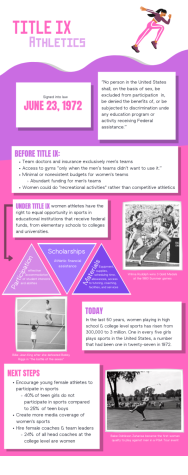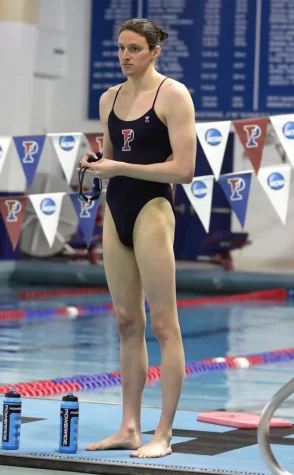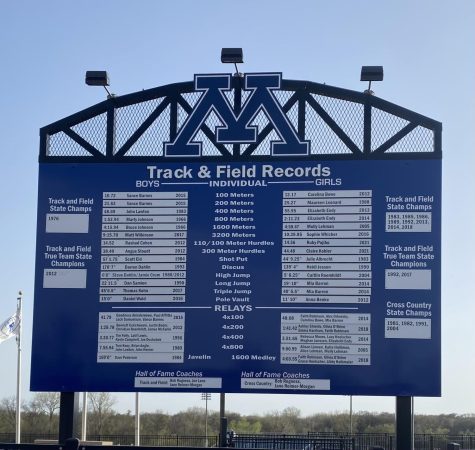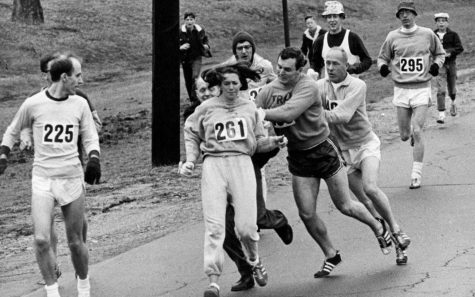Title IX – Women’s Athletic’s
May 16, 2022

Transgender Athletes: Are they protected by Title IX?
Title IX is an act, signed in 1972, that protects participation, benefits, and inclusion in any education program or activity receiving federal assistance from exclusion on the basis of sex. The last 50 years have brought many new opportunities and equity for women in athletics, as well as fostered a more welcoming place for other minority groups, such as the LGBTQIA+ community. Transgender athletes are now pushing to compete freely in athletics according to their gender identity, and this has become a controversial topic for many.
An exemplary transgender athlete is Lia Thomas, a Penn State swimmer. Lia Thomas has posted some record-breaking times, making her “the first known transgender athlete to win a Division I national championship in any sport”. Through this, Lia has garnered both praise and criticism.
Protesters objected to Lia’s participation in the women’s division, gathering outside McAuley Center, where Lia would be competing once more in the 200 and 500 freestyle events. They claimed “the future of women’s sports is at risk and the equal rights of female athletes are being infringed”. Barbara Erhart, the author of the HB 500 (the first law limiting transgender athletes’ ability to participate in athletics that corresponds to their gender identity) also made an appearance. A complaint was also filed against the University of Pennsylvania stating that Lia’s participation in the women’s category violated Title IX.
Some protesters evidenced their argument with the fact that before transitioning, Lia Thomas finished 462nd in the men’s category; now she is 1st. Many individuals say this is unfair, and that her ability to “sweep the floor” is solely due to her sex assigned at birth. This is what makes the topic of trans athletes so controversial; these athletes are technically protected by Title IX, but many cisgender female athletes feel this is “cheating”.
Lia Thomas is also facing backlash on social media platforms. Under a Facebook thread by LowKickMMA that discusses Lia’s national college title win, the comments show some public opinions. Some statements include that “this is just sad”, her participation is a “disgrace”, “shameful”, and that she has “no pride or dignity at all in winning that medal”. Many of the comments also misgender Lia, using he/him pronouns and referring to her as a man. On the contrary, some of the comments defend Lia’s gender identity. One user says “Lia’s identity should be respected, she’s a woman and is still going through her transition”. The thread has hundreds of comments and shares, showing how controversial this topic has become, and many people are willing to express their opinions.
Many of Lia’s fellow athletes and team members have provided her support despite these negative comments and protesters. Schuyler Bailar, a trans-Harvard athlete, called Lia “resilient” for showing up despite hate and protesters and competing. He also said that this was “a symbol that we can both be who we are and do what we love”. Another Virginia athlete said that the focus should now shift to winning the national title, and that they should all view Lia as an equal competitor now.
However, women’s categories in athletics were created separate from the men’s category to create a space where competition level is equal; certain athletes aren’t aided by muscle groups and biological differences specific to each sex. A person assigned male at birth still has many physical differences to a person assigned female at birth. This creates unfair advantages when a person assigned male at birth competes in the women’s category, making the women’s category no longer a space where competition level is equal.
In conclusion, Title IX was created to limit discrimination based on sex in athletic programs that receive funding from the federal government. Title IX affects not just high-school level sports, but also collegiate sports. Because Title IX was created to protect those from sex-based discrimination, the act is not just limited to cisgender females. It also encompasses transgender athletes (both male to female and female to male), those of the LGBTQIA+ community, and those questioning their sexual identity, and allows them to participate freely in programs that receive federal funding.

Minnetonka High School Athletics
Title IX has brought great progress for women’s rights, especially in athletics. In the last 50 years, women have been able to compete in competitive sports, break out of co-ed categories, and level the playing field through equity in sports. However, this equity needs to extend to high school level sports. Data from Minnetonka High school’s last 3 school years shows participation in athletics in both “Boys” and “Girls” categories.

Observations:
- Greater participation in athletics in both “Boys” and “Girls” categories overall each year
- Female athlete participation increases at a much slower rate than male athletes
- Fall 2020 – boys participation increased by 11 athletes, girls participation increased by 2 athletes
- Participation for Girls decreased some seasons
- Winter of 2018-2019
- Winter of 2019-2020
- Spring of 2020
- Girls participation decreased by 38 athletes
- Boys participation increased by 43 athletes
- 200 more Boys athletes than Girl athletes each school year
- Girls participation is on a downward trend
Contradictions:
- For 2018-2021 each MHS graduating class size increased
- 51% of students are male and 49% are female.
- More female teenage athletes should be joining sports teams
- Girls category numbers should be increasing at an equal rate as the Boys
Next Steps:
- Increasing numbers of female athletes
- Bringing attention to Girls sports
- Encourage female athletes to join
- Maintaining welcoming team environments and positive coaching staff/athletes

Women’s Athletic Participation through the 1900’s
Before 1900
- Only allowed to engage in “recreational activities”
- Menstruation believed to make females “periodically weak”
1900s
- Beginning of informal women’s athletic clubs
- Tennis, croquet, bowling, and archery
- Integration of men’s and women’s athletics became more popular.
- “Co-ed” athletic clubs
1920s
- Feminist movement aided in equality between men and women
- The 19th Amendment granted women the right to vote The Nineteenth
1930s
- The Great Depression left many families without jobs, and forced women back into a “homemaker” role.
1940s
- Beginning of World War II
- Left gaps in the workforce with many men deployed overseas
- Women stepped up, getting jobs and gaining freedoms they never had before
- After the war, organizations for women in sport began to increase as sport became more competitive and intercollegiate and interscholastic competition spread
1950s & 1960s
- Civil Rights Movement
- Increased equity for women and other minority groups
- Gymnastics, track & field, swimming, badminton, and volleyball were all added to a schedule of national championships for women’s sports.
1970s
- Focus shifted to federal legislation action to eliminate sexual discrimination
- The Equal Rights Amendment (1972) was pushed
- Proposed designs to equal legal rights for all American citizens regardless of sex
- Prohibited discrimination on the basis of sex and push for legal equity between men and women


